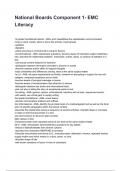National Boards Component 1- EMC
Literacy
1st grade foundational talents - ANS--print capabilities like capitalization and punctuation
-long vs quick vowels, silent e and a few primary vowel groups
-syllables
-digraphs
-where accuracy is commenced to song for fluency
1st informational - ANS--ask/answer questions, become aware of important subject matter/key
info, describe the relationship between individuals, events, ideas, or portions of statistics in a
text.
-use textual content features for facts/info
-distinguish between information provided in pictures vs words
-discover reasons author offers to support thoughts
-basic similarities and differences among texts at the same subject matter
1st Lit - ANS--all same requirements as Kinder, however no prompting or support for key info
category, compare/comparison,and so forth.
-become aware of principal message or lesson
-become aware of words/phrases that attraction to senses
-distinguish between tale books and informational texts
-pick out who is telling the story at exceptional points in text
1st writing - ANS--genres: opinion ,informational, narrative with at least sequenced events,
-with assist, use virtual gear to supply writing
2nd grade foundational - ANS--vowel teams
-decode commonplace prefixes and suffixes
2nd informational - ANS--Identify the principle topic of a multiparagraph text as well as the focal
point of specific paragraphs within the textual content.
-Describe the relationship among a sequence of ancient activities, scientific ideas or concepts,
or steps in technical processes in a text.
Use text functions to discover data correctly
Main reason of text
Compare/contast most important points of two texts at the same subject matter
2d lit - ANS--who/what/in which/while/why questions for key details
-ethical of fables/folktakes from diverse cultures
-describe how characters RESPOND to activities
-Describe how phrases and terms (e.G., everyday beats, alliteration, rhymes, repeated strains)
supply rhythm and which means in a story, poem, or tune.
-describe shape of tale
-well known variations in factor of view of characters
, -compare/comparison or greater variations of the equal tale
2d writing - ANS--genres: opinion, informational, narrative
-use of temporal words
--with help, use virtual tools to supply writing
3rd foundational - ANS--that means of common prefixes and suffixes
-decode words with latin suffixes
-prose and poetry is brought into fluency
3rd informational - ANS-Explain how key details assist important idea
Use language that relates to time, sequence, cause/effect
Distinguish very own factor of view from that of a textual content
third lit - ANS--decide ethical/lesson with textual content proof
-describe characters motivation and show how their moves contribue to collection of activities
-distinguish among literal and nonliteral language
-use terms which includes bankruptcy, scene, and stanza
-evaluate/contrast issues, placing, plot
third writing - ANS--genres: opinions helping factor of view, informational, narrative (real or
made up)
-quick studies initiatives
4 w's (visual literacy approach) - ANS-What do I see? What does it job my memory of? What is
the artist's reason? So what?
4th informational - ANS--summarize nf text
-Interpret records supplied visually, orally, or quantitatively
-provide an explanation for how writer uses reasons/proof
-integrate information at the identical subject matter the usage of texts to jot down or talk
4th lit - ANS--check with examples when explaining
-determine a theme and summarize text
-describe story factors in period, the use of textual content evidence (unique info- movements,
mind, words)
-Determine the that means of words and terms as they may be used in a text, such as people
who allude to extensive characters determined in mythology (e.G., Herculean).
-examine and contrast factor of view (first and third individual)
-examine/assessment treatment of similar topics in memories among distinct cultures in texts
4th nad fifth foundational - ANS--use morphology (roots and affixes) to decode
4th writing - ANS--genres: evaluations with assisting reasons, informational, narrative (real or
made up)
-take into account audience
-use tech along with keyboarding capabilities and internet
-studies projects including different elements of 1 subject matter
five card flicker (visible literacy approach) - ANS-gamers are dealt five random photos. To sell
VL, have college students follow these steps:
Jot down one word that they associate with each photo.
Identify a song that involves mind for one or more of the pics.
Describe what all the snap shots have in not unusual.
Compare solutions with classmates.




